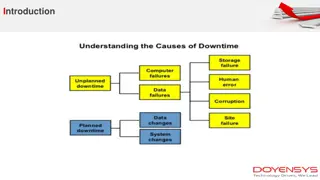Understanding Oracle Stored Procedures and Functions
Explore the capabilities of PL/SQL in Oracle, including the creation and execution of stored procedures, functions, and triggers. Learn how to define and call procedures with examples. Discover how PL/SQL allows for complex data processing and modular business logic implementation.
Download Presentation

Please find below an Image/Link to download the presentation.
The content on the website is provided AS IS for your information and personal use only. It may not be sold, licensed, or shared on other websites without obtaining consent from the author. Download presentation by click this link. If you encounter any issues during the download, it is possible that the publisher has removed the file from their server.
E N D
Presentation Transcript
Oracle Stored Procedures and Functions
What can you do with PL/SQL? Allows sophisticated data processing Build complex business logic in a modular fashion Use over and over Execute rapidly little network traffic Stored procedures Functions Triggers
Stored Procedures Defined set of actions written using PL/SQL When called, the procedure performs actions Can be called directly from other blocks Two parts Procedure specification or header Procedure body
PROCEDURES A procedure is a module performing one or more actions; it does not need to return any values. The syntax for creating a procedure is as follows: CREATE OR REPLACE PROCEDURE name [(parameter[, parameter, ...])] AS [local declarations] BEGIN executable statements [EXCEPTION exception handlers] END [name];
PROCEDURES A procedure may have 0 to many parameters. Every procedure has two parts: 1. The header portion, which comes before AS (sometimes you will interchangeable), keyword (this contains the procedure name and the parameter list), 2. The body, which is everything after the IS keyword. The word REPLACE is optional. When the word REPLACE is not used in the header of the procedure, in order to change the code in the procedure, it must be dropped first and then re-created. see IS they are Bordoloi and Bock
Example: Procedure CREATE OR REPLACE PROCEDURE hello IS Greetings VARCHAR(20); BEGIN Greetings:= 'Hello World'; DBMS_OUTPUT.PUT_LINE(greetings); END hello;
Example: Procedure CREATE OR REPLACE PROCEDURE Discount AS CURSOR c_group_discount IS SELECT distinct s.course_no, c.description FROM section s,enrollment e,course c WHERE s.section_id = e.section_id AND c.course_no = s.course_no GROUP BY s.course_no, c.description, e.section_id, s.section_id HAVING COUNT(*) >=8; BEGIN FOR r_group_discount IN c_group_discount LOOP UPDATE course SET cost = cost * .95 WHERE course_no = r_group_discount.course_no; DBMS_OUTPUT.PUT_LINE ('A 5% discount has been given to'|| r_group_discount.course_no||' '|| r_group_discount.description ); END LOOP; END; Bordoloi and Bock
Calling a Procedure In order to execute a procedure in SQL*Plus use the following syntax: EXECUTE Procedure_name To display output set serveroutput on size 4000 EXECUTE hello; Another way to execute it is from another PL/SQL block: BEGIN hello; END;
Arguments A value can be passed to a procedure when it is called (input) Must specify datatype Example (not actually a procedure): increase_salary_find_tax( increase_percent sal IN OUT tax OUT IN NUMBER:=7, NUMBER, NUMBER) IN means the procedure can read an incoming value from that parameter when the procedure is called OUT means the procedure can use that parameter to send a value back to what called it increase_percent has a default value of 7
Arguments Following is a procedure with arguments: CREATE OR REPLACE PROCEDURE increase (oldprice NUMBER, percent NUMBER := 5, newprice OUT NUMBER) IS BEGIN newprice:=oldprice+oldprice*percent/100; END increase;
Calling a Procedure with Arguments DECLARE price_increase NUMBER(6,2) := 20; newp NUMBER(6,2) := 0; BEGIN DBMS_OUTPUT.PUT_LINE('Current price: '|| price_increase); increase(oldprice=>price_increase,newprice=>newp); DBMS_OUTPUT.PUT_LINE ('Price after increase: '|| newp); END; We should see a new price of 21
PARAMETERS Parameters are the means to pass values to and from the calling environment to the server. These are the values that will be processed or returned via the execution of the procedure. There are three types of parameters: IN, OUT, and IN OUT. Modes specify whether the parameter passed is read in or a receptacle for what comes out.
Types of Parameters Procedure Calling Environ- ment IN Argument OUT Argument IN OUT Argument DECLARE . BEGIN . EXCEPTION . END;
FORMAL AND ACTUAL PARAMETERS Formal parameters are the names specified within parentheses as part of the header of a module. Actual parameters are the values expressions specified within parentheses as a parameter list when a call is made to the module. The formal parameter and the related actual parameter must be of the same or compatible data types.
MATCHING ACTUAL AND FORMAL PARAMETERS Two methods can be used to match actual and formal parameters: positional notation and named notation. Positional notation is simply association by position: The order of the parameters used when executing the procedure matches the order in the procedure s header exactly. Named notation is explicit association using the symbol => Syntax: formal_parameter_name => argument_value In named notation, the order does not matter. If you mix notation, list positional notation before named notation.
MATCHING ACTUAL AND FORMAL PARAMETERS Bordoloi and Bock
FUNCTIONS Functions are a type of stored code and are very similar to procedures. The significant difference is that a function is a PL/SQL block that returns a single value. Functions can accept one, many, or no parameters, but a function must have a return clause in the executable section of the function. The datatype of the return value must be declared in the header of the function. A function is not a stand-alone executable in the way that a procedure is: It must be used in some context. You can think of it as a sentence fragment. A function has output that needs to be assigned to a variable, or it can be used in a SELECT statement.
FUNCTIONS The syntax for creating a function is as follows: CREATE [OR REPLACE] FUNCTION function_name (parameter list) RETURN datatype IS BEGIN <body> RETURN (return_value); END; Bordoloi and Bock
FUNCTIONS The function does not necessarily have to have any parameters, but it must have a RETURN value declared in the header, and it must return values for all the varying possible execution streams. The RETURN statement does not have to appear as the last line of the main execution section, and there may be more than one RETURN statement (there should be a RETURN statement for each exception). A function may have IN, OUT, or IN OUT parameters. but you rarely see anything except IN parameters. Bordoloi and Bock
Example CREATE OR REPLACE FUNCTION show_description (i_course_no number) RETURN varchar2 AS v_description varchar2(50); BEGIN SELECT description INTO v_description FROM course WHERE course_no = i_course_no; RETURN v_description; EXCEPTION WHEN NO_DATA_FOUND THEN RETURN('The Course is not in the database'); WHEN OTHERS THEN RETURN('Error in running show_description'); END; Bordoloi and Bock
Making Use Of Functions In a anonymous block SET SERVEROUTPUT ON DECLARE v_description VARCHAR2(50); BEGIN v_description := show_description(&sv_cnumber); DBMS_OUTPUT.PUT_LINE(v_description); END; In a SQL statement SELECT course_no, show_description(course_no) FROM course; Bordoloi and Bock
Example CREATE OR REPLACE FUNCTION discount (amount NUMBER, percent NUMBER:=5) RETURN NUMBER IS BEGIN IF (amount>=0) THEN return (amount*percent/100); ELSE return(0); END IF; END discount; The IF-THEN construct allows for error checking
Example : Calling the Function DECLARE current_amt NUMBER:=100; incorrect_amt NUMBER:=-5; BEGIN DBMS_OUTPUT.PUT_LINE(' Order and Discount'); DBMS_OUTPUT.PUT_LINE(current_amt || ' '|| discount(current_amt)); DBMS_OUTPUT.PUT_LINE(incorrect_amt||' '||discount(incorrect_amt)); END;
Example Write a PL/SQL function that accepts price and onhand values, checks to be sure they are both greater than 0 and multiplies them together. If they are less than 0 return 0. CREATE OR REPLACE FUNCTION total_amount (price NUMBER, onhand NUMBER) RETURN NUMBER IS BEGIN IF (price>0 AND onhand>0) THEN return (price*onhand); ELSE return(0); END IF; END total_amount;























